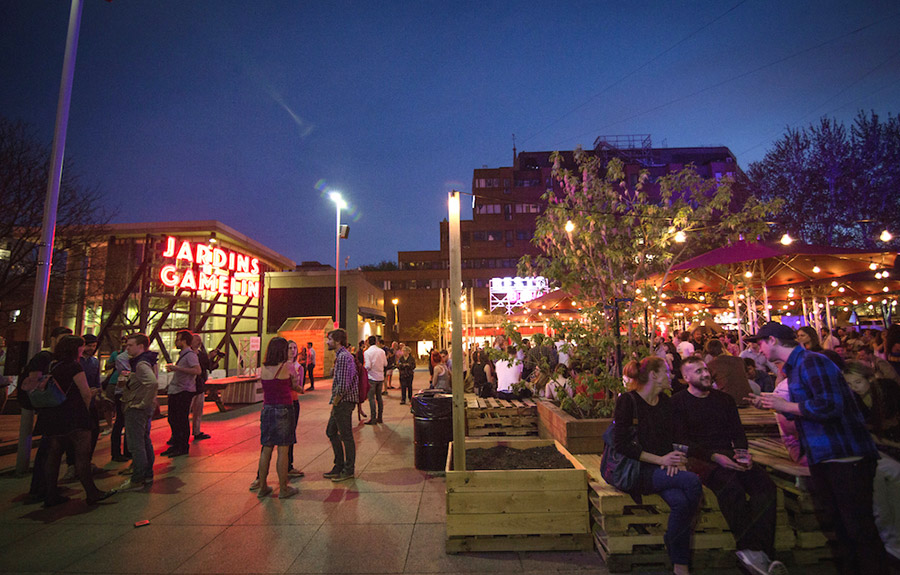2015 - Merit Award
Montreal, Canada
IT’S NOT OFTEN WE ALL GET TO BE TOGETHER LIKE THIS.
AGATHE MOREAU – THE GAZETTE

THE SITE THROUGH TIME
70s -80s
Once a PARKING LOT called Square Berri
Became somehow the city CENTRE because of the metro system and the central bus station
1992
Complete FACELIT for the anniversary of the city
Now called PLACE EMILIE-GAMELIN, in honour of Emilie-Gamelin, a nun that gave a home to the poor in her mansion which once stood on the site
1990s – 2000s
LACK OF ACTIVITIES and decline: the café and ice drink proposed in the original design have never been in operation
It became a refuge for the HOMELESS PEOPLE, drug dealers and crime. Public policies tried to clean the area with laws and repression
2010
The new founded “Quartier des Spectacles” organism now manages the area
Efforts are done to bring life to the area with events, but the effects are only EPHEMERAL
2015
After 5 years of punctual projects, the city mandate the organization to explore a light but SUSTAINABLE APPROACH to bring back a neighbourhood feeling to the area
Under the new name “JARDINS GAMELIN”, the place finally reveals its full daily potential

DEISGN APPROACH
Our approach is inspired by Project for Public Spaces, which states we need an approach holistic, which touches four main aspects: Sociability, Uses & Activities, Comfort & Image, Access & Linkages.
“As both an overarching idea and a hands-on approach for improving a neighborhood, city, or region, Placemaking inspires people to collectively reimagine and reinvent public spaces as the heart of every community. Strengthening the connection between people and the places they share, Placemaking refers to a collaborative process by which we can shape our public realm in order to maximize shared value. More than just promoting better urban design, Placemaking facilitates creative patterns of use, paying particular attention to the physical, cultural, and social identities that define a place and support its ongoing evolution.
With community-based participation at its center, an effective Placemaking process capitalizes on a local community’s assets, inspiration, and potential, and it results in the creation of quality public spaces that contribute to people’s health, happiness, and well being.”
- Fred Kent, Project for Public Spaces

A key element of the Jardin Camelin’s success is the emergence of a community feeling, as diverse as it’s users may be. This feeling was also paired with pride, as users would make the project their own, and were eager to see the project flourish.
The free-picking gardens and the hiring of a full-time gardener were really important to achieve this. The gardens made everyone comfortable, while the gardener introduced the curious to the basics of its job, and more generally acted as a welcoming, stable presence.
However, Jardins Gamelin wouldn’t have been the same if it had not put out efforts towards the inclusion of the homeless, the real inhabitants of the park. A skilled social worker was always on site to help them, but also to teach to the staff of the Jardins Gamelin. Ex-inhabitants of the park that managed to get out of the street were also hired to insure the good running of the operations, and were thus able to properly understand the homeless. Subsequently, the homeless of the park were no outcasts, and happily participate in social activities such as Karaoke and gardening. In the end, they even acted as the nightwatch over the gardens.
The first edition of the Jardins Gamelin is a big leap in a much awaited transformation of the Place Emilie-Gamelin, from dangerous & unappealing to safe and clean. By no means the goal is to clean out it’s usual inhabitants, but rather to ensure tolerance and a safer cohabitation.
Furthermore, the design aimed at creating a human-scale compact zone, where every activity would be really close from each other. This approach helped to create a density of people in specific areas, which brought life to the place. The choice of timber as the main material gave a feeling of warmth, which was topped by a natural atmosphere created by the ubiquitous plants. Jardins Gamelin were then broadcasted far and wide following a solid communication plan.
Neighbouring institutions, merchants & social actors were all invited to intervene in the design process. Student organizations, the national library, restaurants, social workers and a music store, among many others, all took part in the project, coming up with their own events and ideas. The result of such networking is the meshing of the surrounding community altogether in one place, which wouldn’t have occurred if it wasn’t for the Jardins Gamelin.

The place has always been highly central and strategical. What the Jardins Gamelin did is use the place’s potential to make it important and convince the urban community of it’s greatness.
Agile design methodology is a proven and effective practice in the software development world. The underlying theme of this methodology is to develop a system through the combination of small sequenced iterations that are constantly tested by end users.
The design approach used for the transformation of the Place is inspired by this methodology. As a result, the designers were able to test the impact of the users of a great number of elements: programmings, space plannings, installations, commercial offers and menus. This way, the future is built directly by the likes of the community for a holistic result.
Instead of injecting a massive amount of money on a definitive design, should we consider the way we do design through this approach that is lighter, quicker, cheaper?